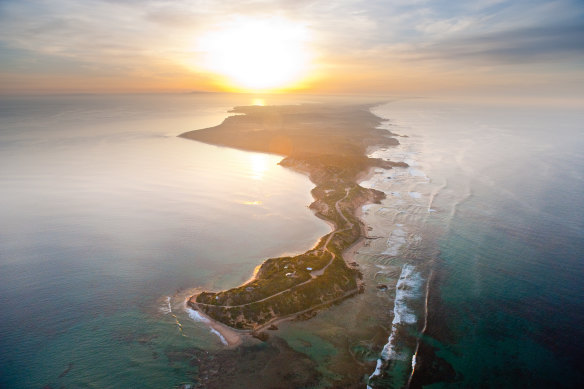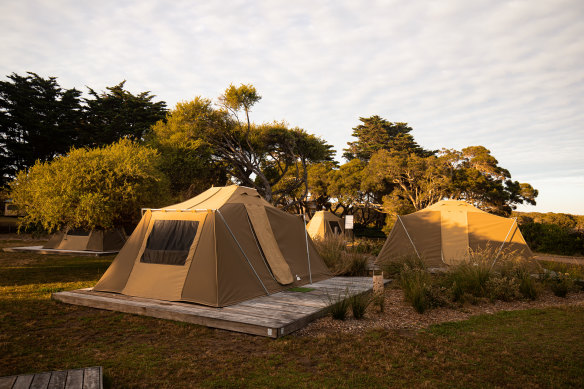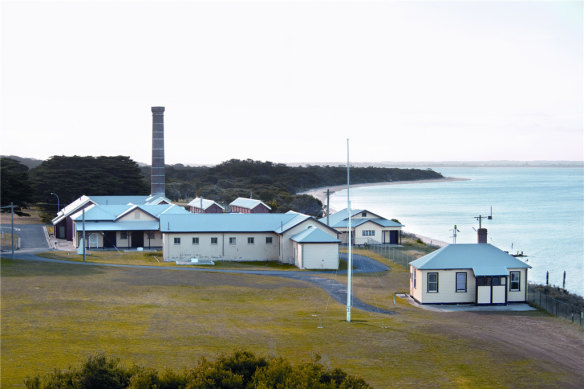This was published 1 year ago
The end point of the Mornington Peninsula is both beautiful and creepy
On an overcast night, cypress trees form haunting sentinels beside decaying buildings that once nursed the infirm and dying. Opposite stands a lonely outbuilding that served as the morgue. And it’s between them that I must walk to access the bathroom before turning in for the night.
Point Nepean National Park, on the westernmost tip of Victoria’s Mornington Peninsula, has housed countless soldiers, migrants and Kosovar refugees in the past 170 years. But tonight, it’s just my family overnighting in the park, set on a windswept promontory between Port Phillip Bay and Bass Strait.

The Mornington Peninsula’s very western tip.
We’ve checked in to Point Nepean Discovery Tents, a pre-erected campground opened for the first full season last summer. Situated on Bunurong Country, the campground sits within the historic Quarantine Station at the gateway to the Fort Nepean military complex. When we arrived, the Sunday market was pumping. But now, in the still of night, it’s a bit creepy. The setting has all the hallmarks of a paranormal fright flick – deserted buildings, rustling branches, shipwreck tales, and two graveyards entombing 400 souls. To top it off, this is where Prime Minister Harold Hold disappeared 57 years ago.
When a wallaby startles me on a late-night loo stop, I’m just grateful the ambush occurs on the return journey. But more than anything, I’m grateful for the solitude, to be staying overnight in this storied place, ensconced by nature a few kilometres from Portsea’s mansions and the tourist bustle of Sorrento.
The 36 pre-erected tents, a combination of twin, family and accessible, are designed to be sympathetic to the park’s natural environment and heritage – a far cry from the $100 million luxury resort proposal scotched almost a decade ago.
“This is a heritage-listed site and we wanted something that wasn’t going to take away from that,” Parks Victoria ranger Kim Taranto explains. “It’s a really special experience in the park because it’s not something we’ve had on offer before.”

Point Nepean Discovery Tents.
For first-time campers, the tents – dotted among tea trees and moonah, on raised timber platforms with camp stretchers – provide a soft introduction to camping. Guests simply bring a sleeping bag, pillow, toiletries and food. A camp kitchen, toilet and shower facilities are available in the repurposed isolation ward, with an adjoining outdoor barbecue area.
For our family, staying overnight is a great way to fully explore the twin heritage sites of the Quarantine Station (opened to the public in 2009 and home to almost 50 heritage buildings), and Fort Nepean, a top-secret defence installation for 70 years up until 1948. Crisscrossing the 560-hectare park are more than 20 kilometres of walking and cycling paths that intersect at the main attractions. We hire ebikes (bayplay.com.au) and take the Coles Track, an old World War II telegraph route, to the base of Cheviot Hill. The viewpoint, overlooking the beach where Holt disappeared, features crumbling observation posts and is named after one of the 50 ships that came to grief at notorious waterway “The Rip” at the entrance to Port Phillip Bay.
Another day, we take the shuttle bus five kilometres to the tip of Fort Nepean and explore the gun emplacements, bunkers, labyrinthine tunnels and underground ammunition storages. It’s here the British Empire’s first shot of World War I was fired, to halt a fleeing German ship. The extraordinary complex is extensive and, at times, eerie – not helped when a tiger snake slithers by my feet in one of the dim tunnels. A highlight is taking the steep flight of stairs to the engine house, where we peer across The Rip to The Bellarine Peninsula in the company of a fur seal.

The Quarantine Station.
At the Quarantine Station, we explore the remains of the jetty, where the first passengers arrived in 1852, disembarking from a ship riddled with typhus, dysentery and measles. We roam the hospital buildings and disinfecting and bathing complex, where luggage was trammed through gas and steam chambers to protect the fledgling colony. We stroll the parade grounds, used by army cadets up until 1985, and see the diminutive Shepherd’s Hut, one of the oldest surviving buildings in Victoria.
But our greatest moments of contemplation come on the beach at sunset when we have the entire park to ourselves.
THE DETAILS
DRIVE
Point Nepean is 112 kilometres south of Melbourne on the Mornington Peninsula.
STAY
Discovery Tents are available from September to April and cost from $124.80 for two. See parks.vic.gov.au
The writer was a guest of Parks Victoria.
Sign up for the Traveller Deals newsletter
Get exclusive travel deals delivered straight to your inbox. Sign up now.